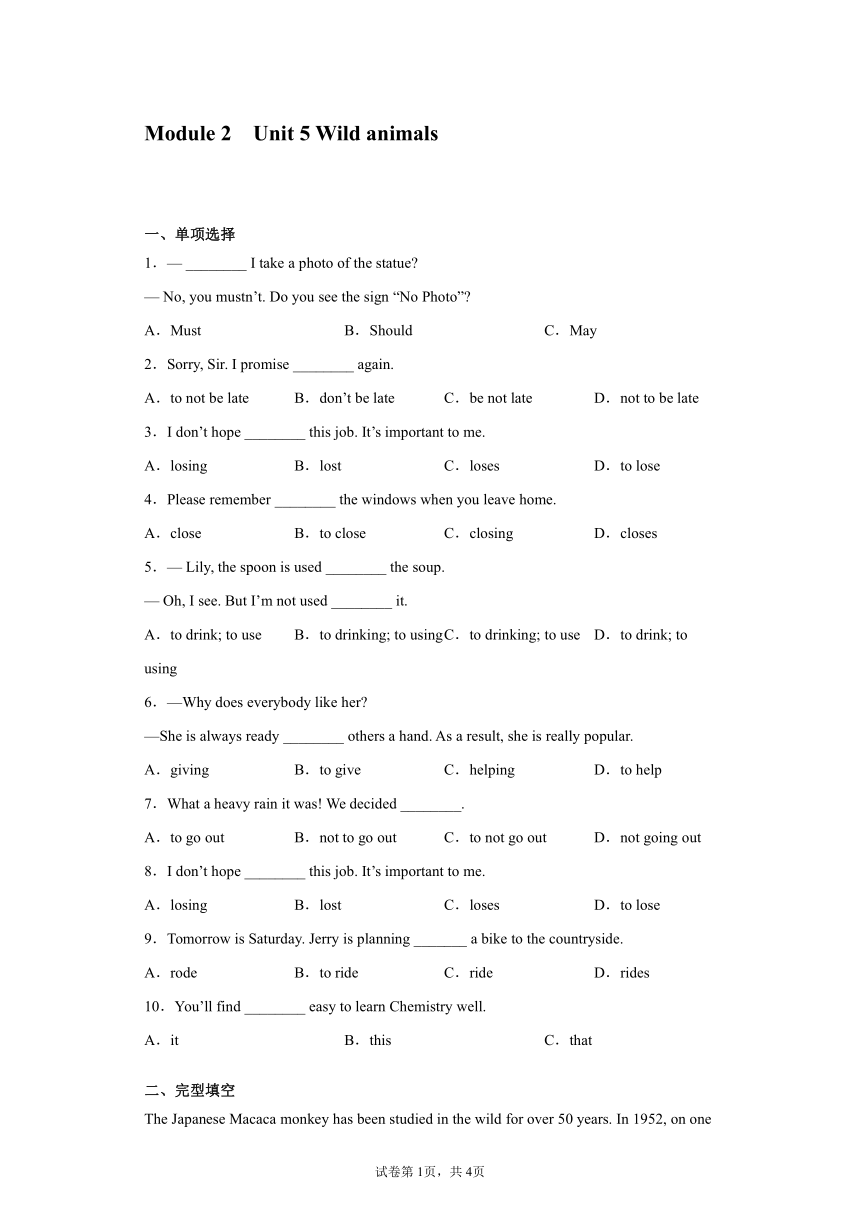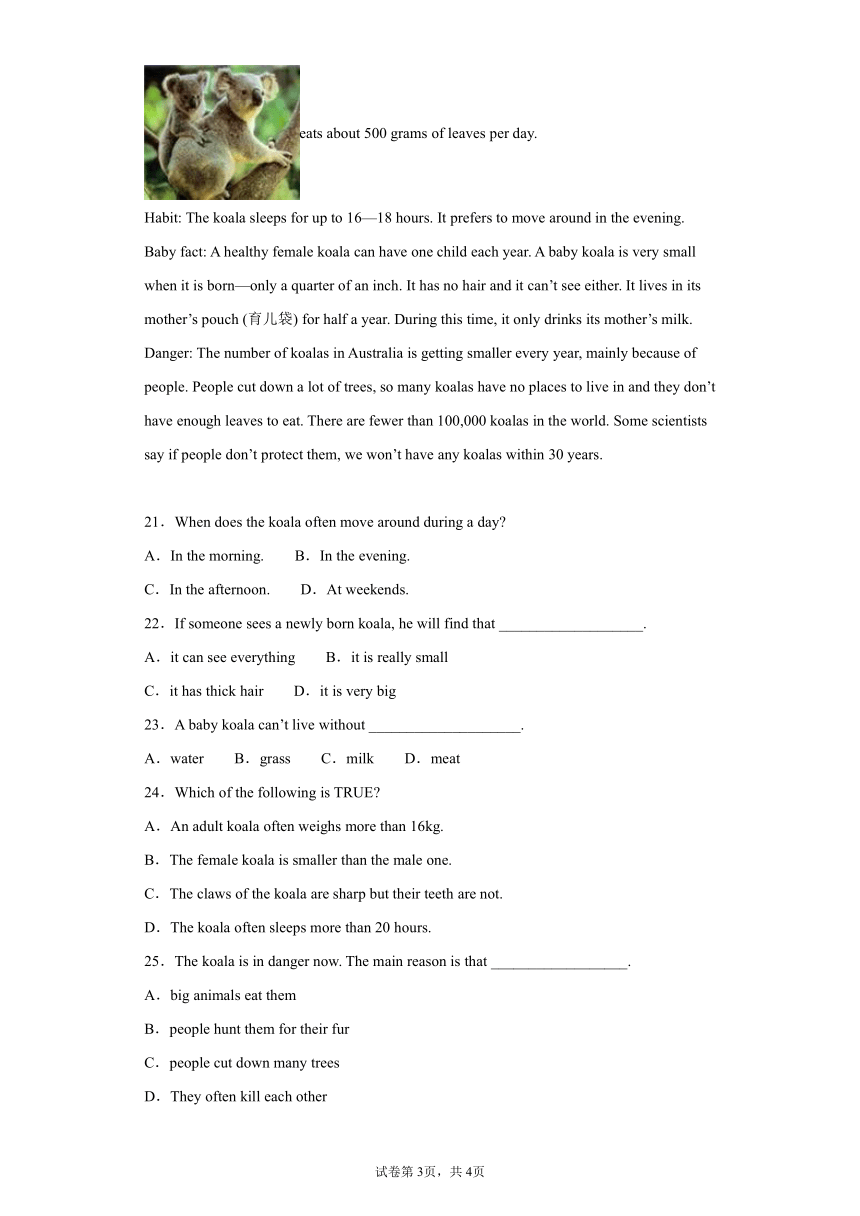牛津译林版八年级上册 英语Module 2 Unit 5 Wild animals -同步训练(含答案)
文档属性
| 名称 | 牛津译林版八年级上册 英语Module 2 Unit 5 Wild animals -同步训练(含答案) |  | |
| 格式 | docx | ||
| 文件大小 | 62.0KB | ||
| 资源类型 | 教案 | ||
| 版本资源 | 牛津译林版 | ||
| 科目 | 英语 | ||
| 更新时间 | 2021-12-23 15:14:10 | ||
图片预览



文档简介
Module 2 Unit 5 Wild animals
一、单项选择
1.— ________ I take a photo of the statue
— No, you mustn’t. Do you see the sign “No Photo”
A.Must B.Should C.May
2.Sorry, Sir. I promise ________ again.
A.to not be late B.don’t be late C.be not late D.not to be late
3.I don’t hope ________ this job. It’s important to me.
A.losing B.lost C.loses D.to lose
4.Please remember ________ the windows when you leave home.
A.close B.to close C.closing D.closes
5.— Lily, the spoon is used ________ the soup.
— Oh, I see. But I’m not used ________ it.
A.to drink; to use B.to drinking; to using C.to drinking; to use D.to drink; to using
6.—Why does everybody like her
—She is always ready ________ others a hand. As a result, she is really popular.
A.giving B.to give C.helping D.to help
7.What a heavy rain it was! We decided ________.
A.to go out B.not to go out C.to not go out D.not going out
8.I don’t hope ________ this job. It’s important to me.
A.losing B.lost C.loses D.to lose
9.Tomorrow is Saturday. Jerry is planning _______ a bike to the countryside.
A.rode B.to ride C.ride D.rides
10.You’ll find ________ easy to learn Chemistry well.
A.it B.this C.that
二、完型填空
The Japanese Macaca monkey has been studied in the wild for over 50 years. In 1952, on one small Japanese island, scientists dropped some 11 in the dirt for the monkeys. The monkeys liked their taste, but they found the dirt to be 12 .One clever 18-month-old monkey found she could 13 the problem by washing the sweet potatoes in a nearby river. She taught this to her mother. Her 14 also learned this new way and they taught their mothers, too.
All the younger monkeys 15 learned to wash the dirty sweet potatoes to make them 16 to eat. But many old monkeys found it very hard to learn this and still ate the 17 sweet potatoes.
Then something very surprising 18 . In the autumn of 1958, scientists found that the monkeys on other nearby 19 began washing their sweet potatoes too. Scientists still don’t fully understand how this knowledge was 20 from one island to another.
11.A.sweet potatoes B.green plants C.fresh nuts D.hard stones
12.A.beautiful B.terrible C.difficult D.interesting
13.A.explain B.reach C.solve D.understand
14.A.children B.brothers C.sisters D.friends
15.A.quietly B.easily C.angrily D.awfully
16.A.cleaner B.smaller C.lighter D.drier
17.A.small B.large C.new D.dirty
18.A.took on B.took off C.took place D.took away
19.A.trees B.island C.beach D.river
20.A.learned B.dropped C.passed D.left
三、阅读单选
The koala
Appearance:
Size: 70—90cm Weight: 5—14kg
The koala with thick hair looks cute but it has very sharp
teeth and claws (爪子).
The male koala is larger than the female one.
Food: The koala eats eucalyptus leaves (桉树叶). Each koala
eats about 500 grams of leaves per day.
Habit: The koala sleeps for up to 16—18 hours. It prefers to move around in the evening.
Baby fact: A healthy female koala can have one child each year. A baby koala is very small when it is born—only a quarter of an inch. It has no hair and it can’t see either. It lives in its mother’s pouch (育儿袋) for half a year. During this time, it only drinks its mother’s milk.
Danger: The number of koalas in Australia is getting smaller every year, mainly because of people. People cut down a lot of trees, so many koalas have no places to live in and they don’t have enough leaves to eat. There are fewer than 100,000 koalas in the world. Some scientists say if people don’t protect them, we won’t have any koalas within 30 years.
21.When does the koala often move around during a day
A.In the morning. B.In the evening.
C.In the afternoon. D.At weekends.
22.If someone sees a newly born koala, he will find that ___________________.
A.it can see everything B.it is really small
C.it has thick hair D.it is very big
23.A baby koala can’t live without ____________________.
A.water B.grass C.milk D.meat
24.Which of the following is TRUE
A.An adult koala often weighs more than 16kg.
B.The female koala is smaller than the male one.
C.The claws of the koala are sharp but their teeth are not.
D.The koala often sleeps more than 20 hours.
25.The koala is in danger now. The main reason is that __________________.
A.big animals eat them
B.people hunt them for their fur
C.people cut down many trees
D.They often kill each other
四、话题作文
26.以“My home town”为题,介绍一下你的家乡变化,40—60词。
试卷第4页,共4页
试卷第3页,共4页
参考答案
1.C
2.D
3.D
4.B
5.D
6.B
7.B
8.D
9.B
10.A
11.A
12.B
13.C
14.D
15.B
16.A
17.D
18.C
19.B
20.C
21.B
22.B
23.C
24.B
25.C
26.My Home Town
My home town is a beautiful place. It stands beside a wide river and is rich in fish and rice.But in the old days it was a poor and backward little town. Many people had no work. They lived a hard life.
In 1949 my hometown was liberated. Since then great changes have taken place there. The streets have been widened. Factories, schools, hospitals, cinemas and theatres have sprung up one after another. The life of the people is greatly improved.
I love my hometown. All the more I love its people. They are working hard so as to make it still richer and more beautiful.
答案第2页,共2页
答案第1页,共1页
一、单项选择
1.— ________ I take a photo of the statue
— No, you mustn’t. Do you see the sign “No Photo”
A.Must B.Should C.May
2.Sorry, Sir. I promise ________ again.
A.to not be late B.don’t be late C.be not late D.not to be late
3.I don’t hope ________ this job. It’s important to me.
A.losing B.lost C.loses D.to lose
4.Please remember ________ the windows when you leave home.
A.close B.to close C.closing D.closes
5.— Lily, the spoon is used ________ the soup.
— Oh, I see. But I’m not used ________ it.
A.to drink; to use B.to drinking; to using C.to drinking; to use D.to drink; to using
6.—Why does everybody like her
—She is always ready ________ others a hand. As a result, she is really popular.
A.giving B.to give C.helping D.to help
7.What a heavy rain it was! We decided ________.
A.to go out B.not to go out C.to not go out D.not going out
8.I don’t hope ________ this job. It’s important to me.
A.losing B.lost C.loses D.to lose
9.Tomorrow is Saturday. Jerry is planning _______ a bike to the countryside.
A.rode B.to ride C.ride D.rides
10.You’ll find ________ easy to learn Chemistry well.
A.it B.this C.that
二、完型填空
The Japanese Macaca monkey has been studied in the wild for over 50 years. In 1952, on one small Japanese island, scientists dropped some 11 in the dirt for the monkeys. The monkeys liked their taste, but they found the dirt to be 12 .One clever 18-month-old monkey found she could 13 the problem by washing the sweet potatoes in a nearby river. She taught this to her mother. Her 14 also learned this new way and they taught their mothers, too.
All the younger monkeys 15 learned to wash the dirty sweet potatoes to make them 16 to eat. But many old monkeys found it very hard to learn this and still ate the 17 sweet potatoes.
Then something very surprising 18 . In the autumn of 1958, scientists found that the monkeys on other nearby 19 began washing their sweet potatoes too. Scientists still don’t fully understand how this knowledge was 20 from one island to another.
11.A.sweet potatoes B.green plants C.fresh nuts D.hard stones
12.A.beautiful B.terrible C.difficult D.interesting
13.A.explain B.reach C.solve D.understand
14.A.children B.brothers C.sisters D.friends
15.A.quietly B.easily C.angrily D.awfully
16.A.cleaner B.smaller C.lighter D.drier
17.A.small B.large C.new D.dirty
18.A.took on B.took off C.took place D.took away
19.A.trees B.island C.beach D.river
20.A.learned B.dropped C.passed D.left
三、阅读单选
The koala
Appearance:
Size: 70—90cm Weight: 5—14kg
The koala with thick hair looks cute but it has very sharp
teeth and claws (爪子).
The male koala is larger than the female one.
Food: The koala eats eucalyptus leaves (桉树叶). Each koala
eats about 500 grams of leaves per day.
Habit: The koala sleeps for up to 16—18 hours. It prefers to move around in the evening.
Baby fact: A healthy female koala can have one child each year. A baby koala is very small when it is born—only a quarter of an inch. It has no hair and it can’t see either. It lives in its mother’s pouch (育儿袋) for half a year. During this time, it only drinks its mother’s milk.
Danger: The number of koalas in Australia is getting smaller every year, mainly because of people. People cut down a lot of trees, so many koalas have no places to live in and they don’t have enough leaves to eat. There are fewer than 100,000 koalas in the world. Some scientists say if people don’t protect them, we won’t have any koalas within 30 years.
21.When does the koala often move around during a day
A.In the morning. B.In the evening.
C.In the afternoon. D.At weekends.
22.If someone sees a newly born koala, he will find that ___________________.
A.it can see everything B.it is really small
C.it has thick hair D.it is very big
23.A baby koala can’t live without ____________________.
A.water B.grass C.milk D.meat
24.Which of the following is TRUE
A.An adult koala often weighs more than 16kg.
B.The female koala is smaller than the male one.
C.The claws of the koala are sharp but their teeth are not.
D.The koala often sleeps more than 20 hours.
25.The koala is in danger now. The main reason is that __________________.
A.big animals eat them
B.people hunt them for their fur
C.people cut down many trees
D.They often kill each other
四、话题作文
26.以“My home town”为题,介绍一下你的家乡变化,40—60词。
试卷第4页,共4页
试卷第3页,共4页
参考答案
1.C
2.D
3.D
4.B
5.D
6.B
7.B
8.D
9.B
10.A
11.A
12.B
13.C
14.D
15.B
16.A
17.D
18.C
19.B
20.C
21.B
22.B
23.C
24.B
25.C
26.My Home Town
My home town is a beautiful place. It stands beside a wide river and is rich in fish and rice.But in the old days it was a poor and backward little town. Many people had no work. They lived a hard life.
In 1949 my hometown was liberated. Since then great changes have taken place there. The streets have been widened. Factories, schools, hospitals, cinemas and theatres have sprung up one after another. The life of the people is greatly improved.
I love my hometown. All the more I love its people. They are working hard so as to make it still richer and more beautiful.
答案第2页,共2页
答案第1页,共1页
